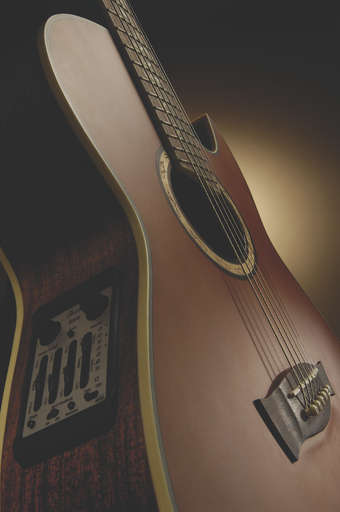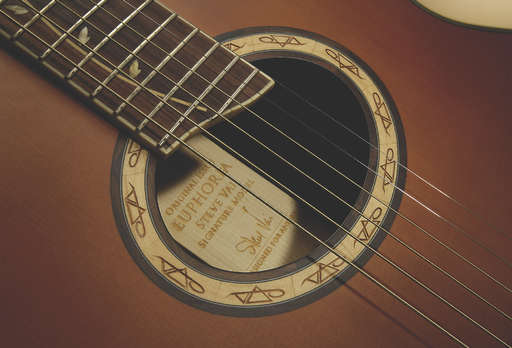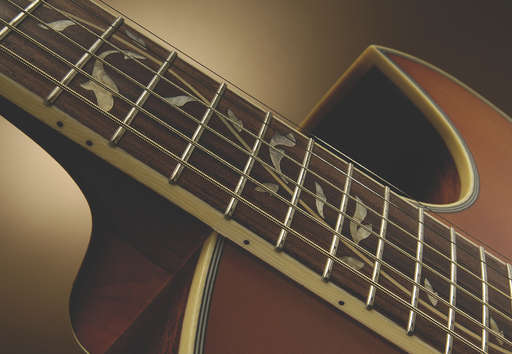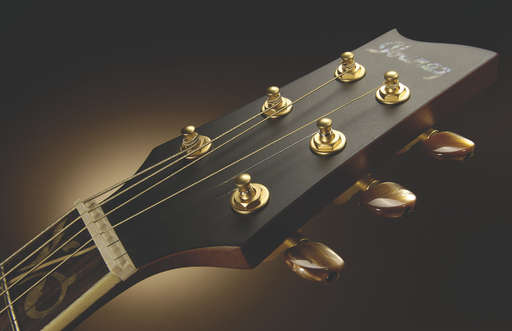MusicRadar Verdict
Not only does this model offer a marked improvement over its predecessor the EP7 in every department from electronics to tonewoods, but it also achieves the elusive balance struck by few signature models; managing to appeal to both Vai fans and guitarists who simply appreciate great playability, comfort and tone.
Pros
- +
Fantastic raw tone. Aura preamp is versatile and offers realistic mic 'sim' sounds.
Cons
- -
Vai fans might be let down by the lack of visual nods to their hero.
MusicRadar's got your back

Ibanez EP9 Euphoria

Ibanez EP9 Euphoria

Ibanez EP9 Euphoria

Ibanez EP9 Euphoria

Ibanez EP9 Euphoria
The EP9 Euphoria is not Ibanez's first attempt to create a signature acoustic for Steve Vai. Lest we forget, this model follows on the heels of the original EP7, which was launched to great fanfare at Los Angeles' NAMM trade show in 2004.
Three years later, the production run of the EP7 ended and the EP9 emerged to replace it. Vai himself refers to this newer version of the Euphoria as the 'older younger brother' of the original, but that's a slightly misleading description.
Design
In terms of aesthetics, electronics and tonewoods, there are major differences between the two, to the point where it's possible to view the EP9 as both a totally new design and a veiled admission that its predecessor was lacking in certain areas. Putting aside the price cut (in the UK the EP9 costs £100 less than its forebear) the most immediate differences here are cosmetic.
By Ibanez's own admission, the forest green colouration of the EP7 was a dividing factor, and here it has been replaced by a low gloss resonant root beer finish that will surely cast this model's commercial net wider. Another notable visual improvement is the addition of a yellow pearloid 'Tree Of Life' fretboard inlay (the original was green), while Vai's 'Light Without Heat' symbols make a welcome reappearance on the EP9's custom wood soundhole rosette (formerly brass). Despite these embellishments, and the presence of Vai's autograph on the soundhole label, the EP9 generally keeps its signature status under its hat - presumably to attract more neutral players.
More significant changes are afoot beneath the surface. Where the EP7 employed quilted maple for its soundboard and body, the EP9 turns to the more traditional combination of solid Engelmann spruce for its top, solid African mahogany as the basis of its body and neck, and rosewood to fill what little space is left by the extravagant inlay on the bound fretboard. The grain is generally even cross the top (if slightly less so around the sides), while the hardware is dependable stuff, with Ivorex used to neat effect at the EP9's nut and saddle, and Advantage pins locking the D'Addarios in place convincingly at the bridge. Frustratingly, Ibanez has retained the tortoiseshell buttons on the Grover tuners, but these are perhaps the only real missed trick on a package that does real credit to Ibanez's Chinese operation.
Ultimately, while the relative merits of tonewoods and cosmetics are open to debate, the EP9's one undeniable trump card lies in its pairing of a Fishman Acoustic Matrix piezo with a Fishman Onboard Aura preamp (the EP7 featured the more pedestrian B-Band UST pickup and A5 preamp). A system that has featured on various Martin acoustics to great effect, the Aura combines the convenience of a pickup with the sound quality achieved by mic'ing up. Instead of a physical microphone, of course, it offers a selection of six 'Sound Images' based on a series of pro mics.
In use
Vai's pre-eminence as a shredder implies that his signature acoustic should be capable of audacious techniques, and while this proved the case, the EP9 certainly doesn't rule out less flamboyant players. With a manageable body depth that places you close to the action and a neck profile that should feel familiar to aficionados of the EW and AEL lines, the EP9 is an unqualified physical success, whether you're sliding chord shapes up and down the length of the neck, racing through fast and loose legato passages, or soloing across the two octaves of fretboard unlocked by the generous cutaway.
Unamplified, the EP9 presents a strong argument for its revised combination of spruce and mahogany. The tone is bright and characterful with fingers, yet retains its natural warmth and depth when you dig in with a plectrum. Overall, there's a great sense of tonal balance, and an authoritative level of volume that (combined with the playable neck) ensures you don't have to work too hard to get your point across.
Assuming you combine it with a competent acoustic amp (we used a Headway SK120), the Matrix piezo allows impressively clean amplification of the EP9's raw tone, particularly when you iron out interference using the anti-feedback switch. Rather than colouring this, the Aura's six Sound Images bring different aspects of the EP9's tone to the fore by placing a series of 'virtual mics' at a variety of 'virtual distances'. At this, we felt it was a huge success.
Cycling through the six settings via the intuitive dial brings great versatility to the table, and from the close virtual mic'ing of the Beta 58A to the distant placement of the Neumann U47, the level of realism makes the EP9 a serious option for professional musicians.
MusicRadar is the number one website for music-makers of all kinds, be they guitarists, drummers, keyboard players, DJs or producers...
- GEAR: We help musicians find the best gear with top-ranking gear round-ups and high-quality, authoritative reviews by a wide team of highly experienced experts.
- TIPS: We also provide tuition, from bite-sized tips to advanced work-outs and guidance from recognised musicians and stars.
- STARS: We talk to musicians and stars about their creative processes, and the nuts and bolts of their gear and technique. We give fans an insight into the craft of music-making that no other music website can.
“Delivers streamlined DAW integration with an excellent hammer action keyboard”: Arturia Keylab 88 Mk3 review
“I have an original 909 – every time I try to use it I feel like I’m ruining it”: House hero Riva Starr on his studio essentials and his love of analogue synths
“A synthesizer that is both easy to use and fun to play whilst maintaining a decent degree of programming depth and flexibility”: PWM Mantis review










